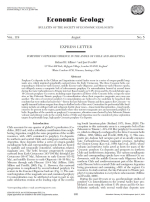Добрый день, Коллеги. Важное сообщение, просьба принять участие. Музей Ферсмана ищет помощь для реставрационных работ в помещении. Подробности по ссылке
Porphyry copper recurrence in the Andes of Chile and Argentina / Цикличность медно-порфировых систем в Чилийских и Аргентинских Андах
Porphyry Cu deposits in the Chilean and Argentinian central Andes occur in a series of orogen-parallel magmatic arcs, which migrated episodically eastward since the Early Cretaceous. The three Cenozoic belts, corresponding to Paleocene-early Eocene, middle Eocene-early Oligocene, and Miocene-early Pliocene epochs, cut obliquely across a composite belt of subeconomic porphyry Cu mineralization formed at several times during the Late Carboniferous to Triassic interval. Based mainly on U-Pb zircon and Re-Os molybdenite ages, 10 Cenozoic porphyry Cu centers, including major deposits in all three of the Cenozoic belts, occupy the same sites as late Paleozoic-Triassic porphyry Cu mineralization where their respective magmatic arcs cross one another. The sites of recurrent porphyry Cu mineralization are believed to be underlain by long-lived dike conduits that were utilized at least twice—first in the late Paleozoic-Triassic and then again in the Cenozoic—to rapidly transmit hydrous magma from deep to shallow levels of the crust. Contenders for preferential dike localization include arc-oblique fault and subjacent ductile shear zones—transcrustal discontinuities—long hypothesized to be present in the region, particularly where they intersect magmatic arcs and associated porphyry Cu belts. Regardless of the controls on porphyry Cu recurrence, alteration zones hosted by late Paleozoic-Triassic volcanic and plutonic rocks in the central Andes of Chile and Argentina must be considered prime exploration targets for potentially large, high-grade Cenozoic porphyry Cu deposits. <...>




